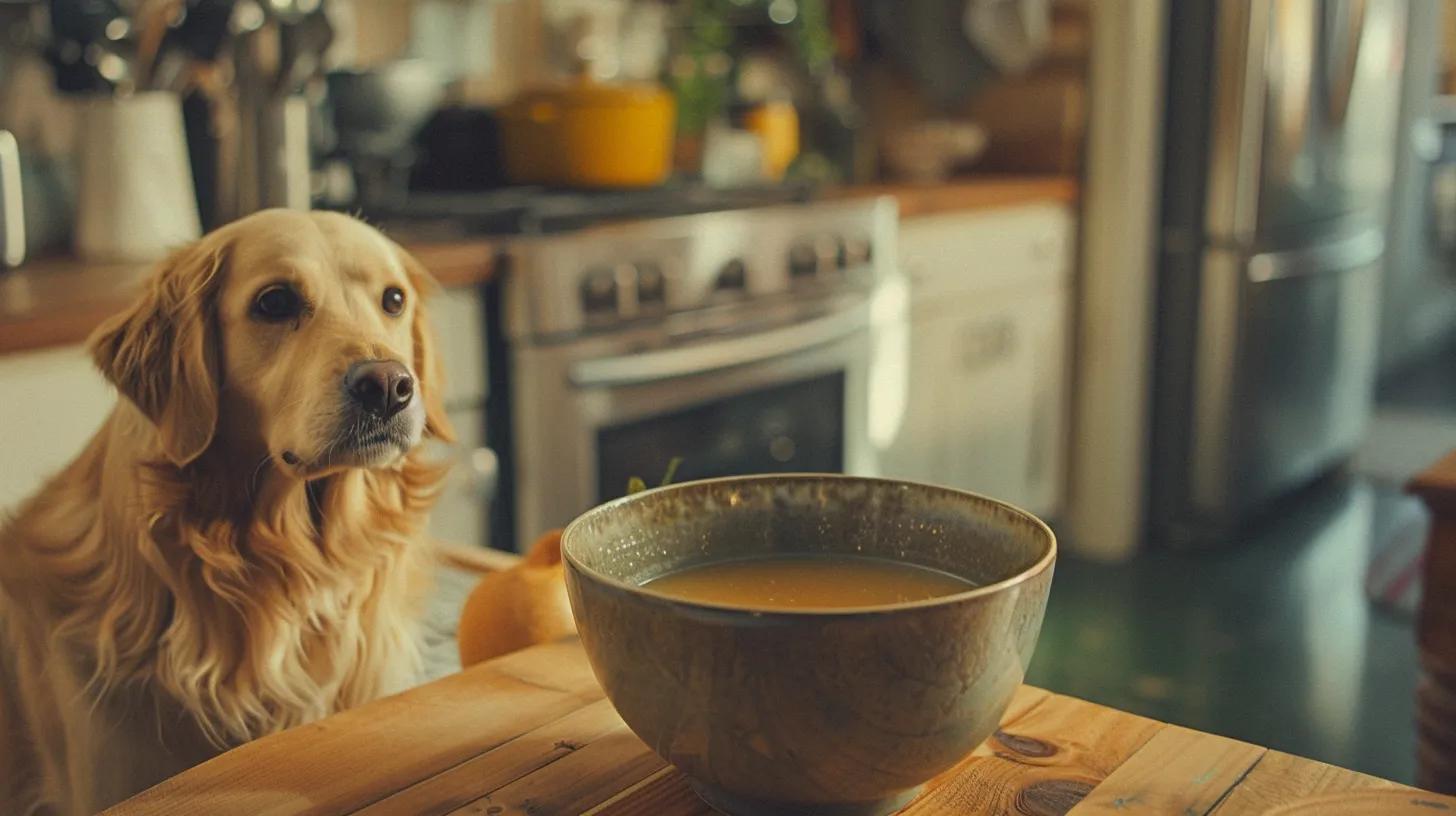
Nourish Your Pup With Homemade Bone Broth for Dogs
Homemade bone broth for dogs is becoming a favorite among pet owners due to its natural, nutrient-rich profile that supports various aspects of canine health. Recognized not just as a tasty treat but as a functional health supplement, bone broth can improve digestion, boost the immune system, support joint health, and enhance skin and coat quality. In an era focused on high-quality, wholesome diets, preparing bone broth at home ensures optimal nutrition while avoiding harmful additives found in some store-bought alternatives.
This guide covers everything pet owners need to know about canine bone broth—from understanding its unique composition and differences from regular stock to crafting a homemade recipe that preserves vital nutrients. You will find step-by-step instructions on selecting the best bones, choosing nourishing ingredients, methods for slow cooker or stovetop preparation, and detailed insights into the health benefits, proper serving sizes, creative ways to add it to your dog’s diet, and essential storage tips.
By the end of this comprehensive guide, you will understand how to incorporate bone broth into your dog’s daily routine to support a holistic approach to canine wellbeing.
Transitioning now to a deep dive into the nature and unique benefits of bone broth for dogs, the following sections answer essential questions and provide actionable instructions that transform bone broth from a kitchen experiment into a powerful tool for your pet’s nutrition.
Understanding Bone Broth for Canine Health
What Constitutes Bone Broth for Dogs?
Bone broth for dogs is a liquid nutritional supplement made by simmering animal bones with water and a few dog-safe additions. The process releases gelatin, collagen, glucosamine, and chondroitin from the bones—key to healthy joints, skin, and connective tissues. Prepared over a long period, the slow breakdown of bones maximizes nutrient extraction without using seasonings (such as onions or garlic) that are harmful to dogs. The resulting broth is both a tasty treat and an excellent base for homemade dog food recipes, helping to stimulate appetite, aid digestion, and support recovery after illness or surgery.
Distinguishing Bone Broth From Regular Stock
Unlike conventional stock, bone broth is simmered for 24 to 48 hours to extract deep-seated nutrients, while regular stock cooks for only a few hours and is often seasoned. Bone broth remains unseasoned to maintain its purity for canine consumption. Ingredients like celery, carrots, and a bit of apple cider vinegar are used instead, ensuring a nutrient-rich drink that supports joint health, improves digestion, and enhances coat quality.
Key Nutrients Found in Canine Bone Broth
The simmering process liberates essential amino acids (such as glycine and proline), which are vital for protein building and cellular repair. Collagen transforms into gelatin, which supports a healthy gut lining and aids digestion. Glucosamine and chondroitin support joint health, while minerals like calcium, phosphorus, magnesium, and potassium help maintain bone strength and muscle function. The addition of apple cider vinegar further increases mineral bioavailability, and the anti-inflammatory properties help reduce systemic inflammation.
How Bone Broth Supports Dog Wellbeing
Bone broth improves digestive health by strengthening the gut lining and enhancing nutrient absorption. Its gelatin and collagen support the gut and joint tissues, reducing inflammation and discomfort in aging or arthritic dogs. Regular consumption can promote a shinier coat, improve mobility, and boost the immune system. Used both as a standalone supplement or mixed into homemade dog food, bone broth helps ensure your pet receives essential proteins, amino acids, and minerals, addressing multiple aspects of their wellbeing.
Crafting Your Own Bone Broth for Dogs

Selecting the Best Bones for Your Dog's Broth
Choose bones rich in marrow, cartilage, and connective tissue such as knuckle bones, marrow bones, and even feet. Organic, grass-fed, or pasture-raised bones are preferred for higher nutrient density and lower contaminants. Popular choices include chicken, pork, and beef bones. For example, chicken feet offer high collagen content, while beef marrow bones provide ample minerals. Avoid cooked or processed bones to prevent splintering and internal damage.
Essential Ingredients for a Nutrient-Rich Dog Bone Broth
In addition to high-quality bones, use water as the nutrient extraction medium and add a splash of apple cider vinegar (about one tablespoon per pot) to help release minerals. Dog-safe vegetables like carrots, celery, and parsley enhance the broth’s flavor and nutritional profile. These ingredients boost benefits such as improved skin, coat health, and digestion while avoiding toxic ingredients like onions, garlic, or excessive salt.
Step-by-Step Guide to Making Bone Broth for Dogs
- Gather Clean, High-Quality Bones – Use grass-fed or organic bones such as knuckle or marrow bones.
- Rinse and Prepare Bones – Wash thoroughly to remove impurities.
- Assemble Ingredients – Place bones, filtered water, apple cider vinegar, and dog-safe vegetables (carrots, celery, parsley) in a large pot or slow cooker.
- Simmer the Broth – Bring to a boil, then reduce to a low simmer for 24–48 hours, allowing maximum nutrient extraction.
- Skim Impurities – Remove foam periodically using a fine mesh strainer.
- Strain and Cool – Remove solids by straining through cheesecloth; allow the broth to cool.
- Store Safely – Transfer to airtight containers; refrigerate for up to 5 days or freeze for longer storage.
Slow Cooker Method for Dog Bone Broth Preparation
Using a slow cooker maintains a consistent low temperature ideal for nutrient extraction. Place cleaned bones and vegetables in the slow cooker with water and a splash of apple cider vinegar. Set to low and let simmer for 24 to 48 hours. This method minimizes supervision while ensuring the broth develops a rich, gelatinous texture without unnecessary additives.
Stovetop Instructions for Homemade Canine Broth
Alternatively, use a large stockpot on the stovetop. Bring the mixture (bones, water, apple cider vinegar, and vegetables) to a gentle boil over medium-high heat, then lower to a simmer. Stir occasionally to prevent rapid boiling that may degrade nutrients. Maintain a low simmer for 24 to 48 hours, skimming impurities as needed. Strain the liquid carefully once finished.
Benefits of Homemade Bone Broth for Your Dog
Promoting Healthy Digestion With Bone Broth for Dogs
Bone broth supports the gastrointestinal tract by fortifying the gut lining and aiding nutrient absorption. Its gelatin helps soothe inflammation and can improve bowel regularity. This gentle, easily digestible food is beneficial for dogs with sensitive stomachs or chronic digestive issues, contributing to a stable and resilient digestive system.
Supporting Joint Health in Dogs With Bone Broth
The collagen, gelatin, glucosamine, and chondroitin in bone broth work together to promote cartilage repair and joint cushioning. These nutrients can reduce arthritic discomfort and support mobility in aging or active dogs, serving as a natural alternative to some pharmaceuticals by reducing systemic inflammation.
Boosting Your Dog's Immune System Naturally
Bone broth’s rich blend of amino acids, antioxidants, and minerals helps strengthen the gut barrier, which is essential for a robust immune system. Its anti-inflammatory properties further reduce oxidative stress, supporting overall health and improving recovery times when illness strikes.
Enhancing Skin and Coat Health Through Bone Broth
Regular consumption of bone broth promotes a shiny, healthy coat by providing the collagen needed for skin elasticity and moisture. The gelatin helps improve skin texture and can reduce irritations and dryness, benefiting dogs suffering from skin conditions or allergies.
Aiding Liver Detoxification With Canine Bone Broth
The nutrient-dense profile of bone broth supports liver function by aiding in detoxification processes. Amino acids like glycine help the liver metabolize and eliminate toxins more effectively, while the minerals support enzymatic pathways. This gentle detoxification is especially beneficial for older dogs or those exposed to environmental toxins.
Serving Homemade Bone Broth to Your Dog

Appropriate Serving Sizes of Bone Broth for Dogs
Adjust serving sizes by your dog’s size, weight, age, and activity level. Generally: - Small dogs (under 20 pounds): 1/4 to 1/2 cup per serving. - Medium to large dogs: 1/2 to 1 cup per serving. For puppies or dogs recovering from illness, begin with small amounts and slowly increase as tolerated. Bone broth should supplement a balanced diet, not replace complete meals.
Creative Ways to Add Bone Broth to Your Dog's Diet
Here are several creative ideas: 1. Dry Food Topper – Pour warm bone broth over kibble to enhance flavor and nutrition. 2. Gravy Mix – Blend into wet food to create an appetizing gravy. 3. Chilled Treats – Serve spoonfuls of refrigerated broth as a refreshing treat. 4. Frozen Broth Cubes – Freeze in ice cube trays for a hydrating snack post-exercise. 5. Training Reward – Use small amounts as a high-value training incentive. 6. Smoothie Ingredient – Mix with dog-safe fruits and vegetables for a nutrient-packed beverage. 7. Soup Base – Incorporate into homemade stews and casseroles for enhanced flavor and nutrition.
Using Bone Broth for Hydration and Appetite Stimulation
Bone broth is excellent for hydrating dogs and stimulating their appetite, especially for those recovering from illness or under stress. Its high water content helps maintain hydration levels, while its rich flavor encourages even picky eaters to drink and eat more. This dual action supports overall detoxification and immune function.
Making Frozen Bone Broth Treats for Dogs
For a refreshing, hydrating snack, pour cooled bone broth into silicone molds or ice cube trays and freeze. These bite-sized treats help keep your dog cool on hot days and provide a concentrated dose of nutrients. For added variety, mix in small amounts of dog-safe fruits or vegetables before freezing.
Incorporating Bone Broth Into Homemade Dog Food Recipes
Bone broth can enhance the richness and palatability of homemade dog food. Replace part of the water or stock in recipes with bone broth to infuse additional flavor and nutrients. This method works well in recipes for stews, casseroles, or gravy-like mixes, ensuring balanced nutrition and better meal acceptance.
Storing and Preserving Your Homemade Dog Bone Broth
Refrigerating Homemade Bone Broth for Canine Consumption
After cooking and cooling, store bone broth in airtight containers in the refrigerator for up to five days. Allow it to cool at room temperature first to prevent condensation, which can affect quality. Refrigeration also helps set the gelatin, producing a thicker texture many dogs enjoy.
Freezing Bone Broth for Dogs for Long-Term Use
For longer storage, freeze the broth in freezer-safe containers or silicone molds. Ice cube trays work well for creating pre-portioned treats. Thaw only the portion needed by gently microwaving or leaving in the refrigerator overnight, ensuring the nutrient integrity is maintained.
Proper Cooling Techniques for Homemade Dog Broth
Cool the broth slowly at room temperature, or speed up the process by placing the pot in an ice bath, stirring occasionally. Once cooled, transfer immediately to refrigerated or frozen storage to reduce the risk of bacterial growth.
How Long Does Homemade Bone Broth Last for Dogs?
Homemade bone broth lasts up to five days in the refrigerator and three months or longer in the freezer. Use airtight, food-grade containers and inspect the broth for any signs of spoilage such as off odors, textures, or colors before serving.
Important Considerations for Dog Bone Broth

Ingredients to Avoid When Making Bone Broth for Dogs
Avoid harmful additives such as onions, garlic, and excessive salt, as well as leeks and chives, which can be toxic to dogs. Processed or pre-seasoned bones should also be avoided to prevent splintering and potential choking hazards. Use only natural, unprocessed ingredients to maintain safety and maximize health benefits.
Is Store-Bought Bone Broth Safe for Dogs?
Some store-bought broths may contain preservatives, seasonings, and high sodium levels that can harm dogs. While premium pet-specific brands exist, homemade bone broth gives you full control over the ingredients, ensuring a safe and nutrient-rich product. Always consult your veterinarian if unsure about any commercial options.
Addressing Common Concerns About Bone Broth for Canines
Common concerns include potential allergies, contamination, and nutritional imbalances. Most dogs tolerate well-made, dog-safe bone broth. Introduce it gradually, monitor for digestive upset or allergic reactions, and use proper hygiene during preparation to reduce contamination risks. Remember, bone broth is a supplement to a balanced diet rather than a complete meal replacement.
When to Introduce Bone Broth to Your Dog's Diet
Bone broth can be introduced at any life stage. Puppies should begin with small amounts after weaning. Adult dogs, especially those with digestive issues, joint pain, or signs of aging, can benefit from slow integration into their daily diet. For recovering or older dogs, gradual introduction ensures maximum benefits without overloading their digestive system, and veterinary guidance is recommended.
Observing Your Dog for Any Reactions to Bone Broth
Monitor your dog closely after introducing bone broth. Positive signs include improved appetite, higher energy, shinier coat, and better joint mobility. If you notice any digestive upset, lethargy, or other adverse reactions, reduce the serving size or consult your veterinarian. Keeping a log of your pet's responses can help optimize the benefits.
Storing and Preserving Your Homemade Dog Bone Broth: Summary Table
| Storage Method | Duration | Key Considerations | Benefits |
|---|---|---|---|
| Refrigeration | Up to 5 days | Use airtight containers; cool before storing | Maintains freshness; convenient daily use |
| Freezing | Up to 3+ months | Use freezer-safe containers; portion control | Long-term preservation; quick thaw for treats |
| Proper Cooling Techniques | Immediate cooling | Use ice bath or room temperature cooling | Prevents bacterial growth; retains nutrients |
| Monitoring for Spoilage | Regular checks | Inspect odor, color, texture | Ensures safety; avoids nutrient loss |
| Portioning (Ice Cubes/Molds) | Varies | Freeze individually for convenience | Easy serving; prevents waste |
| Labeling with Dates | Essential | Mark date of preparation | Facilitates first-in, first-out use |
| Safe Thawing Techniques | Thaw as needed | Thaw in refrigerator or gently microwave | Retains nutrient integrity; safe to use |
Important Considerations for Dog Bone Broth: Checklist List

- Select High-Quality Bones – Choose organic or grass-fed bones rich in marrow and cartilage.
- Avoid Harmful Ingredients – Exclude onions, garlic, and toxic additives.
- Monitor Serving Sizes – Adjust portions based on your dog’s weight, age, and needs.
- Utilize Dog-Safe Vegetables – Use carrots, celery, and parsley for added nutrition.
- Follow Safe Cooking Practices – Simmer for 24 to 48 hours and skim off impurities.
- Store Properly – Refrigerate for short-term use; freeze for long-term storage.
- Observe Your Dog – Introduce gradually and watch for any adverse reactions.
Frequently Asked Questions
Q: How often should I serve bone broth to my dog? A: For most dogs, adding bone broth once or a few times a week is sufficient. Small dogs may require smaller, more frequent doses, while larger dogs can handle larger portions. Always start with a small amount to gauge tolerance and consult your veterinarian for personalized advice.
Q: Can bone broth replace my dog’s regular meals? A: No, bone broth should supplement your dog’s diet, not replace complete meals. It lacks the full range of proteins, fats, and carbohydrates necessary for a balanced diet, so it’s best used as a topper or mix-in.
Q: Is it safe to add vegetables to the bone broth for dogs? A: Yes. Dog-safe vegetables such as carrots, celery, and parsley not only add flavor but also boost the nutritional profile. Avoid toxic vegetables like onions, garlic, or leeks.
Q: What are the signs that my dog is benefiting from bone broth? A: Improved digestion, increased appetite, shinier coat, and better joint mobility are common positive signs. More energy and overall vitality may also be observed over time.
Q: Can puppies benefit from bone broth, and when should I introduce it? A: Puppies can benefit once they are fully weaned. Introduce small amounts gradually, and consult your veterinarian to determine appropriate portion sizes.
Q: How do I ensure that homemade bone broth remains free of harmful bacteria? A: Maintain hygiene by using fresh, high-quality bones and dog-safe ingredients. Simmer the broth for 24–48 hours, cool it rapidly using an ice bath or similar method, and store it in airtight containers. Always inspect the broth before serving.
Final Thoughts
Nourishing your pup with homemade bone broth is a natural way to provide essential nutrients that support digestive health, joint maintenance, immune function, and overall vitality. By selecting high-quality ingredients and following proven cooking methods, you can be sure your dog receives a safe, nutrient-dense supplement that complements a balanced diet. The versatility of bone broth—as a topper, treat, or ingredient in homemade recipes—makes it an accessible and effective addition to any pet's nutritional regimen. Embracing this wholesome approach not only enhances your furry friend’s quality of life but also fosters a deeper connection through mindful, regular feeding practices.





